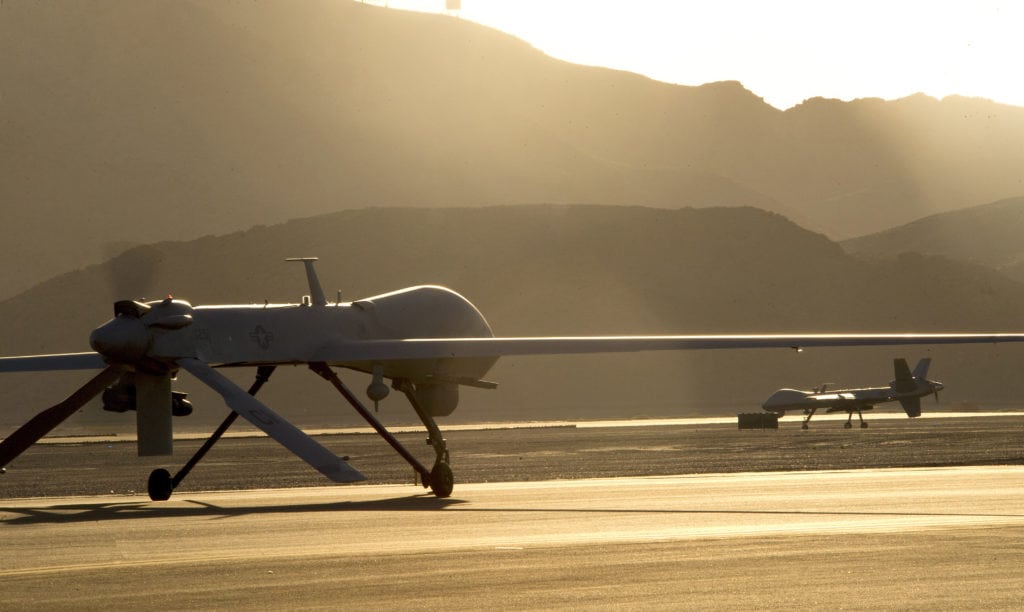
The MQ-1B Predator won’t have the necessary speed to keep up with future helicopters. Photo by Christian Clausen courtesy of U.S. Air Force
Aside from developing a revolutionary new family of rotorcraft, the U.S. Army’s ongoing Future Vertical Lift (FVL) program includes building a next-generation unmanned aircraft system (UAS) that will fly in formation with those future helicopters, operate autonomously or swarm enemy air defenses.
FVL seeks a family of rotorcraft that eventually will replace legacy helicopters with new designs that can fly farther and faster than the current AH-64 Apache, UH-60 Black Hawk and CH-47 Chinook platforms.
Legacy MQ-1 Gray Eagles and RQ-7 Shadow drones won’t be able to keep up with helicopters that can fly 250 knots or faster so new UAS must be developed alongside FVL platforms, according to Juanita Harris, director of the Aviation and Missile Research Development and Engineering Center (AMRDEC), who spoke at the Association of the U.S. Army’s annual Global Force Symposium in Huntsville, Alabama.
Brig. Gen. Wally Rugen, who leads the FVL cross functional team (CFT), said the program’s goal is to build an aviation family that is optimized for large-scale combat operations and is survivable in contested, urban environments where the Army expects to fight in the future.
The FVL CFT is pursuing four means toward that goal, first of which is developing an advanced UAS and the autonomous systems and artificial intelligence that will allow it to operate independently or teamed with a manned aircraft.
“We see that as a purpose-built platform, not a multi-mission system,” he said at AUSA. “It will likely have multiple form factors, be low-observable, survivable or if inexpensive, throw-away.”
The UAS should also be capable of swarming, be capable of taking off and landing without a runway and be optimized to deliver targeting data for manned aircraft and indirect fire at ranges out to where the Army’s new long-range precision fires solution can reach, Rugen said. Other possible applications are delivery of non-lethal effects like electronic attack and radar jamming or spoofing.
The ongoing joint-multirole technology demonstration (JMR-TD) that is essentially a tech maturation and fly-off effort between two competing industry teams, will inform the second and third lines of effort: creating an armed reconnaissance aircraft and a long-range assault helicopter.
The recon helicopter will be an optionally-manned clean-sheet design with autonomy “baked in” that has improved range and survivability over the Apache, which is currently conducting that mission, Rugen said. The long-range assault helicopter will be similar but optimized for speed, range and endurance while carrying assault troops, which will require significant increases in platform protection from guided munitions.
Underpinning all three efforts is the development of a common set of open-architecture standards that will allow all three platforms to be rapidly upgraded as new technologies emerge. Both Harris and Rugen named open architecture mission systems as a key component for the success of the program.
“When we think open systems architecture, we want an architecture that is both open and resilient, government-designed and defined specs that you as industry teammates plug into so we can shorten our typical five-to-seven years upgrade (schedule) into something much shorter,” Rugen said.
While the Army will continue to incrementally upgrade the legacy rotorcraft, the CFT is specifically tasked with looking out 20 or 30 years to envision what vertical-lift capabilities the Army will need and work backward from that, said Vice Chief of Staff Gen. James McConville. Vertical lift capability – not necessarily helicopters as they are known today – will likely be used for the same basic battlefield purposes, but on a very different battlefield than the Army has become used to, he said.
“We use them to find things. We use them to kill things, and we use them to move things,” McConville said. “As we go into the future and we look out 20, 30 years from now, what we see is we still think that we’re going to be finding things. We still think we’re going to need vertical lift to kill things and we still think that we’re going to need to be moving both troops and cargo throughout the battlefield.
“The difference is how we’ll do that,” he added. “The difference is the conditions we are going to operate under.”
This was originally published at sister publication Defense Daily.